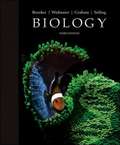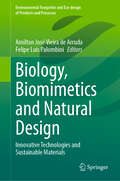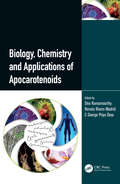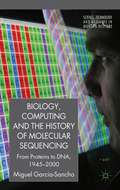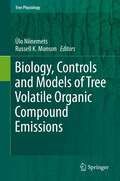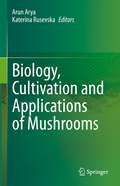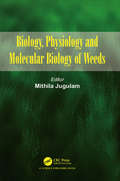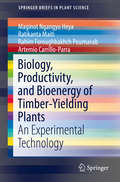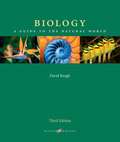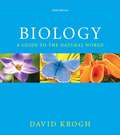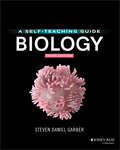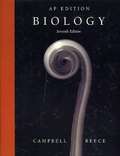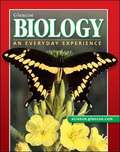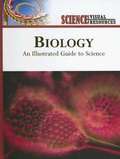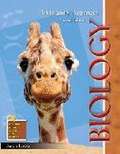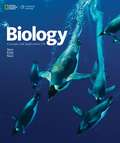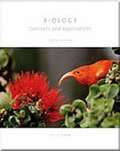- Table View
- List View
Biology, 3rd Edition
by Robert J. Brooker Linda Graham Peter Stiling Eric WidmaierThe first and second editions of BIOLOGY, written by Dr. Rob Brooker, Dr. Eric Widmaier, Dr. Linda Graham, and Dr. Peter Stiling, has reached thousands of students and provided them with an outstanding view of the biological world. Now, the third edition has gotten even better! The author team is dedicated to producing the most engaging and current text that is available for undergraduate students who are majoring in biology. The authors want students to be inspired by the field of biology and become critical thinkers. They understand the goal of a professor is to prepare students for future course work, lab experiences, and careers in the sciences. Building on the successes of the first and second editions, the third edition reflects a focus on core competencies and provides a more learner-centered approach. The strength of an engaging and current text is improved with the addition of new pedagogical features that direct the students' learning goals and provide opportunities for assessment, to determine if students understand the concepts.
Biology, Biomimetics and Natural Design: Innovative Technologies and Sustainable Materials (Environmental Footprints and Eco-design of Products and Processes)
by Felipe Luis Palombini Amilton José Vieira de ArrudaFor billions of years, nature has provided efficient solutions to complex problems, by means of natural selection, in a harsh environment that only the fittest organisms survived. Such sustainable – still ruthless – driven evolution can be explored by designers, architects, engineers and more for the development of innovative projects. Biomimetics makes the link between Biology and Design, where features like shapes, mechanisms, colors, structures, and more can be analyzed, organized, modeled, and simulated for application in multiple creations. Therefore, such knowledge can contribute to more efficient and innovative solutions to many fields of applied science. This project aims to highlight some of the recent technological breakthroughs in Biology, Biomimetics and Natural Design that contribute to the development of sustainable and innovative materials and projects. This work consists of contributions from some of the main international groups of Biomimetics, exhibiting exciting cases of how technological advancements are leading to improved design solutions as well as shaping our very comprehension of nature and its complex organization.
Biology, Chemistry and Applications of Apocarotenoids
by Siva Ramamoorthy Renata Rivera Madrid C George DossCarotenoids are a large class of isoprenoid pigments produced by plants and certain microbes. More than 700 naturally occurring carotenoids have been identified. Apocarotenoids are tailored from carotenoids by oxidative enzymes. Apocarotenoids act as visual or volatile signals to attract pollinating and seed dispersal agents. They are also the key players in allelopathic interactions and plant defense. Biology, Chemistry and Applications of Apocarotenoids provides detailed account of the fundamental chemistry of apocarotenoids and the basic methods used in carotenoid research, and critical discussions of the biochemistry, functions, and applications of these important compounds. Topics covered in the proposed book include various aspects of the roles of apocarotenoids in colour and colouration, photosynthesis and other photofunctions and protection. The formation and roles of carotenoid metabolites and breakdown products as perfume/aroma compounds are also be outlined. Features: Provides an organized overview of apocarotenoids and their chemistry and biological functions Focuses on recent discoveries on apocarotenoids, their nature and functions. Details potential uses of apocarotenoids in agriculture, pharmacy, food industry, and apocarotenoid production at industrial level This book has been written by leading experts in apocarotenoid research and gives a comprehensive overview on the diversity of apocarotenoid compounds and would serve as a reference book for researches in Plant Physiology, Molecular Biology, Biochemistry, Biophysics and Medicine.
Biology, Computing, and the History of Molecular Sequencing: From Proteins to DNA, 1945-2000 (Science, Technology and Medicine in Modern History)
by Miguel García-SanchoSequencing is often associated with the Human Genome Project and celebrated achievements concerning the DNA molecule. However, the history of this practice comprises not only academic biology, but also the world of computer-assisted information management. The book uncovers this history, qualifying the hype and expectations around genomics.
Biology, Controls and Models of Tree Volatile Organic Compound Emissions (Tree Physiology #5)
by Russell K. Monson Ülo NiinemetsPlant-driven volatile organic compound (BVOC) emissions play a major role in atmospheric chemistry, including ozone and photochemical smog formation in the troposphere, and they extend the atmospheric lifetime of the key greenhouse gas, methane. Furthermore, condensation of photo-oxidation products of BVOCs leads to formation of secondary organic aerosols with profound implications for the earth's solar radiation budget and climate. Trees represent the plant life form that most contributes to BVOC emissions, which gives global forests a unique role in regulating atmospheric chemistry. Written by leading experts in the field, the focus is on recent advancements in understanding the controls on plant-driven BVOC emissions, including efforts to quantitatively predict emissions using computer models, particularly on elicitation of emissions under biotic and abiotic stresses, molecular mechanisms of volatile synthesis and emission and the role of emissions in plant stress tolerance.
Biology, Cultivation and Applications of Mushrooms
by Arun Arya Katerina RusevskaThe edited book consolidates information for profitable commercial cultivation of medicinal mushrooms. The book suggests a large number of substrates to the growers for use in commercial cultivation of Mushrooms. It also elucidates the conservation of wild endangered medicinal mushrooms. Mushrooms are the fungal fruiting bodies which can be seen by naked eyes and collected by hands. These are extremely heterogeneous organisms characterized by high levels of species diversity and are widespread in all environments. Researches conducted by score of mycologists and biotechnologists, have resulted in the continuous discovery of new species and the variability of environments where fungi can be harvested, including air, space the seabed. The fields of applications are unfolding a panorama of uses in varied fields, ranging from agriculture, bioremediation, forestry, food, cosmetics, medical, and in pharmaceutical sectors. The book comprises of three parts, first mentions their applications in Ayurvedic and traditional system of Chinese medicine for the cure of ailments. The truffles are delicious, while many others are recommended, as cure in deadly diseases like cancer, COVID-19, and HIV, as well as memory and longevity enhancer. Lentinus, Ganoderma, and Cordyceps are considered good as antioxidant and cure for inflammation. Second part deals with their occurrence in different habitats and seasons and their biology. Enzymes and mechanisms involved in biodegradation and anatomical details of rotting wood. The third part brings about the need of mushroom technology in improving rural economy. This book is a useful read for researchers and students in agriculture, agronomy and researchers working on mushrooms.
Biology, Physiology and Molecular Biology of Weeds
by Mithila JugulamThe book provides comprehensive information on a wide range of topics from biology, physiology, genetics to the use of genomic tools in weed science. The book covers information at a more advanced level than the previously published books in weed science. It covers not only weed genetics and genomics research, but also weed management from an ecological perspective. Furthermore, the book also gives a broad coverage of novel mechanisms of weed resistance to herbicides. More importantly, it includes next generation sequencing techniques and bioinformatics of herbicide resistant genes in weeds.
Biology, Productivity and Bioenergy of Timber-Yielding Plants: An Experimental Technology (SpringerBriefs in Plant Science)
by Ratikanta Maiti Maginot Ngangyo Heya Rahim Foroughbakhch Pournavab Artemio Carrillo-ParraFace to the current global energy crisis, there is an urgent necessity of searching for alternatives to fossil fuels, and this book shows how timber is a promising resource for sustainable energy production. Northeast Mexico represents an important forest resource to satisfy the needs of the population in these areas. In order to harness these forest resources, technology for exploring these valuable resources must be developed. These technologies (with special reference to biology and wood technologies) are available in scattered form in a few books but there is no central, comprehensive source for practical forest scientists for adopting efficient forest management, practice, and exploration. This book deals with the characterization of the vegetation, morphology, phenological development, biomass production (leaf, litter, wood), and bioenergy of some timber-yielding species of Northeast Mexico, which will serve as a guide to study timber-yielding plants in the native vegetation of Tamaulipan thornscrub and experimental plantations. This includes morphology, vegetation cover, biomass production in terms of volume leaf biomass, litter, and volume of fire wood and timber. Special emphasis is given to the estimation of bioenergy products and chemical composition (Ph, extractable lignin, and inorganic elements). Large variations exist in vegetation cover, morphology, phenological development, biomass production of leaf and litter, volume of wood and various variable of bioenergy products among the selected species. The maximum production was found in summer and the volume of the harvestable timber was obtained in experimental plantations. This book, therefore, will serve as a practical handbook to characterize timber-yielding plants, which will help to efficiently manage forestry resources.
Biology: A Guide to the Natural World (3rd edition)
by David KroghA book students enjoy reading, this was written and illustrated to guide non-majors through biological concepts and develop their sense of scientific literacy.
Biology: A Guide to the Natural World (5th Edition)
by David KroghDavid Krogh's Biology: A Guide to the Natural World leads readers on a memorable journey through the world of biology, using relevant examples, clearly-developed illustrations, and helpful insights that resonate with today's students. Widely-recognized as a book that students enjoy reading, the Fifth Edition has been thoroughly updated with new discussions on social concerns and health applications, along with streamlined chapter summaries and expanded review questions.
Biology: A Self-Teaching Guide
by Steven D. GarberAn Interactive, Easy-to-Use Introductory Guide to Major Biology Concepts For students looking for a solid introduction to Biology, the new 3rd Edition of Biology: A Teaching Guide is the perfect learning tool. The latest edition has been updated to include the most up-to-date information on everything from photosynthesis to physiology. For students preparing for exams or individuals who want to review material from years past, the step-by-step format is designed to help students and teachers alike easily understand complex concepts, key terms, and frequently asked questions. The guide includes a comprehensive glossary and self-test questions in each chapter, allowing students to reinforce their knowledge and better understand the concepts. In A Teaching Guide, learn about the foundational aspects of biology, including: ● How photosynthesis occurs ● Whether viruses are living or dead ● The reproductive sexual terms behind cloning ● Comprehensive treatment of all aspects of life science Thoroughly updated with self-teaching practice exams and questions, this comprehensive guide is designed to give students the tools they need to master the fundamental concepts and critical definitions behind biology.
Biology: AP (7th Edition)
by Jane B. Reece Neil A. CampbellThis special edition of Campbell/Reece BIOLOGY, Seventh Edition, is designed specifically for the Advanced Placement Biology community of teachers and students. The book's front section includes a few customized items specific to the needs of AP teachers and students.
Biology: AP Edition (8th edition)
by Jane B. Reece Neil A. CampbellThe text's hallmark values of accuracy, currency, and passion for teaching and learning have made Campbell/Reece the most successful biology book for students and instructors.
Biology: An Everyday Experience
by Lucy Daniel Albert Kaskel Paul J. Hummer Jr.Biology: An Everyday Experience not only presents information, it asks thought-provoking questions. Labs bring the text to life as you use scientific methods to solve problems. You will see how biology affects you as a consumer and learn about careers in biology. Take time now to see what your textbook offers.
Biology: An Everyday Experience
by Lucy Daniel Albert Kaskel Paul J. Hummer Jr.Guide all your students to success in biology Biology: An Everyday Experience is designed for students with a broad range of abilities. This comprehensive course of study in biology emphasizes fundamental concepts of biology and their everyday applications, critical-thinking and study skills, and hands-on experiences. The text applies the study of biology to students' everyday worlds, thereby making it relevant and exciting. Everyday analogies illustrate all major concepts and make biology more understandable. The program has a controlled reading level to allow the presentation to be accessible to all students.
Biology: Bullet Guides
by Silvia NewtonOpen this book and you will Discover how living organisms work Grasp the key concepts Fill gaps in your knowledge Understand the terminology
Biology: Concepts And Applications
by Cecie Starr Lisa Starr Christine A. EversIn the new edition of BIOLOGY: CONCEPTS AND APPLICATIONS, authors Cecie Starr, Christine A. Evers, and Lisa Starr have partnered with the National Geographic Society to develop a text designed to engage and inspire. This trendsetting text introduces the key concepts of biology to non-biology majors using clear explanations and unparalleled visuals. While mastering core concepts, each chapter challenges students to question what they read and apply the concepts learned, providing students with the critical thinking skills and science knowledge they need in life. Renowned for its writing style the new edition is enhanced with exclusive content from the National Geographic Society, including over 200 new photos and illustrations. New People Matter sections in most chapters profile National Geographic Explorers and Grantees who are making significant contributions in their field, showing students how concepts in the chapter are being applied in biological research. Each chapter concludes with an 'Application' section highlighting real-world uses of biology and helping students make connections to chapter content.
Biology: Concepts And Applications
by Cecie Starr Lisa Starr Christine A. EversNIMAC-sourced textbook
Biology: Concepts And Applications
by Cecie Starr Lisa Starr Christine EversShould there be warning labels on fast foods? Should employers be allowed to require drug testing? <P><P>This introductory text teaches you basic concepts of biology in context of critical issues. The Tenth Edition of BIOLOGY: CONCEPTS AND APPLICATIONS was developed in partnership with the National Geographic Society, known for its eye-opening photography and legacy of inspiring people. <P><P>The result is a text that combines clear explanations with unparalleled visuals to introduce the process of science and core concepts of biology. "Engage" boxes help you see chapter concepts being put to work in the real world; "Learning Objectives" help focus your studying; "Applications" bring chapter content to real life; "Figure It Out" questions help you check understanding; and "Data Analysis" activities strengthen your analytical skills. <P><P>This book is widely praised for clear and engaging writing, exceptional art, and terrific support from media that all work together to help you "get" biology.
Biology: Concepts And Applications
by Cecie Starr Lisa Starr Christine A. EversNIMAC-sourced textbook
Biology: Concepts and Applications
by Cecie Starr Lisa Starr Christine A. EversBIOLOGY: CONCEPTS AND APPLICATIONS supplies an 800 page, introductory issues-oriented approach with enormous instructional power. Starr supports mastery throughout while encouraging the critical thinking students need as citizens, voters, parents, and consumers. The "Impacts, Issues" and "How Would You Vote?" features new to this edition make biology come alive. An "Impacts, Issues" case study opens each chapter focusing on a biology-related societal issue. Short films that expand on the issue are on the free Student CD. Each chapter's "How Would You Vote?" asks students to consider biology-related news, apply knowledge, cast a vote on the web and see state and nationwide voting tallies. The access codes that accompany all new copies provide online access to 1) BiologyNow, a learning tool that helps students assess their unique study needs through pretests, post-test and personalized learning plans; 2) InfoTrac, a library of full text articles; 3) vMentor, a live tutoring service and 4) "How Do I Prepare," a feature that allows students to review basic math, chemistry, and other skills that will help them more easily master introductory biology. And now with an MP3 download of this title, you don't have to lose prep time during a long commute'any MP3 player lets you or your students listen and review the text at the gym, in the library, at the office ? anywhere! Starr is the most successful author in non-majors biology because of her clear and engaging writing
Biology: Concepts and Connections (4th Edition)
by Jane B. Reece Neil A. Campbell Martha R. Taylor Lawrence G. MitchellThis book makes students familiar with the scientific process, in particular with the posing and testing of hypotheses. With an improved introduction to the process of science in Chapter 1, students will be better equipped to appreciate the many examples throughout the book of how scientific concepts emerge from observations and experimental evidence. The book also puts human faces on science with "Talking About Science" modules. A number of these profiles of interesting scientists are new to this edition.
